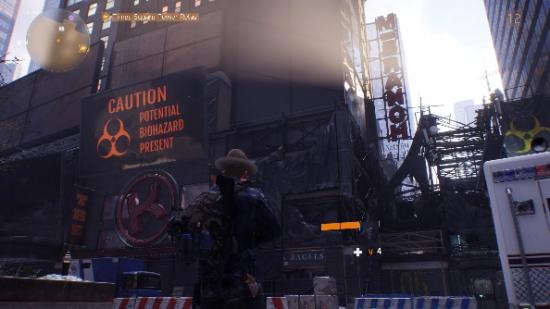Ubisoft have been making open worlds for eons now, but they’ve finally managed to make one that actually feels authentic in The Division. Its New York is built at near-enough 1:1 scale, and includes practically every iconic Manhattan landmark you can think of. And, despite being decimated by plague and mostly evacuated, it feels genuinely alive. A perfect day/night cycle provides chilly mornings and bright afternoons, and the weather ranging from light mist to full-on blizzard generates a genuine sense of place. There’s not a city in gaming that comes close to it.
Need to know if your PC is up to powering apocalyptic New York? Check out our The Division PC port review.
Of course, what you actually do in The Division is more important than where you do it, and that brings us to this review. Arguably Ubisoft’s most ambitious project since the original Assassin’s Creed, The Division is made up of seemingly thousands of components and multiple layers, so to start with it’s best I try and clarify what kind of game it actually is.
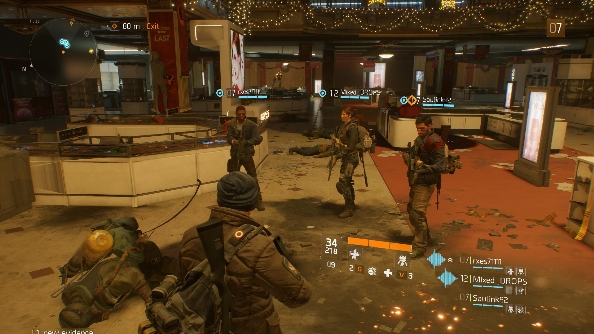
Marketing hype and press coverage has made the game out to be a cover shooter, an RPG, an MMO, or an open-world sandbox. In truth it’s a combination of all these things, but the one I’d suggest you push out of your mind is MMO.
The Division is not World of Warcraft in the slightest; aside from the fact that your weapons and equipment are governed by stats and percentages, there’s little that links it to MMORPGs. You don’t meet hundreds of players in the streets, and NPCs don’t glow when they’re ready to offer mundane quests. Instead, it’s an open-world game akin to Ubisoft’s other efforts. Like almost all games in this genre, when you open your map you’ll find dozens of coloured markers denoting tasks to complete. These include main missions, collectible items, and – yes – even a take on the infamous Ubisoft tower.
These make up the PvE elements of the game, and should keep you busy for a good 30 hours. Main missions push the story forward, side quests offer a chance to deeper explore the world and backstory, while ‘encounters’ are small distractions that take barely a few minutes but still offer solid rewards. That’s certainly one of The Division’s strongest elements: even picking up a collectable results in a nice chunk of XP, meaning chasing down every last abandoned mobile phone helps further your character.
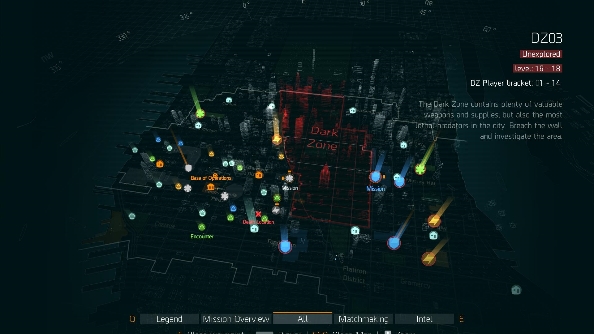
Main missions and encounters fall into three categories – medical, tech, and security – and completing them provides you with points to upgrade the relevant wing of your Base of Operations. Improve the medical wing, and not only will your base begin to fill with patients looking for aid, but you’ll unlock new healing skills, too. More on that later.
The campaign comprises of 16 story missions that will take you from Madison Square Garden to the UN Assembly in pursuit of a cure for Green Poision: a plague that erupted on Black Friday thanks to toxins spread via bank notes. What was once a few punch-ups over discount Blu-ray players is now a city-wide civil war, and it’s up to The Division – a secret collection of sleeper agents hidden among New York’s population, ready to be activated should such a terrible occurrence happen (honestly) – to bring civilization back from the brink. That involves finding a cure for the virus, and wiping out the gangs that are currently battling for ownership of the city.
Missions are designed to be played as part of a four-person co-operative squad, and that’s exactly how they should completed. While you can attempt them solo, they’re filled with overwhelming hordes and heavily armoured boss characters that make them a nightmare for a lonesome player. For teams though, they provide consistently entertaining and tactically engaging challenges.
Getting going with a team is simple: the gateway to each mission has a floating HUD indicator that’ll matchmake you with others wanting to play that same mission. When grouped up, you can stick with them for the long haul and continue to explore the world as a group post-mission, or simply jump back into your own, solitary version of New York.

Cover-shooting makes up the bulk of each assignment, as your squad gradually forces their way deeper into various locations around the city. The shooting frequently feels like you’re firing blow pipes thanks to the lack of rattling feedback on the guns, and quite often you’ll get stuck to cover, but despite those flaws the game still provides a compelling and oddly moreish combat system. There’s an elegance to the way your agent runs from cover to cover, and the game’s heavy use of HUD elements shows you exactly where grenades will explode or health will be dispensed, meaning you can quickly react accordingly.
Enemies are massive bullet-sponges, taking entire clips of bullets to the face before going down. Even when you’re high level and geared up with advanced weapons, the game’s scaling means your adversaries will always present the same kind of challenge. That’s a key failing: no matter how far up the XP ladder you climb, you rarely feel powerful.
But the increased duration it takes to kill the opposition means there’s more time to employ tactics: you can flank and deploy gadgets effectively when it’s not one-shot-and-it’s-over. And The Division really does require those tactics: while not demanding quite the brutal efficiency of Rainbow Six Siege, coordination is an absolute must against the gangs of flamethrower-wielding nutcases and armoured PMCs.
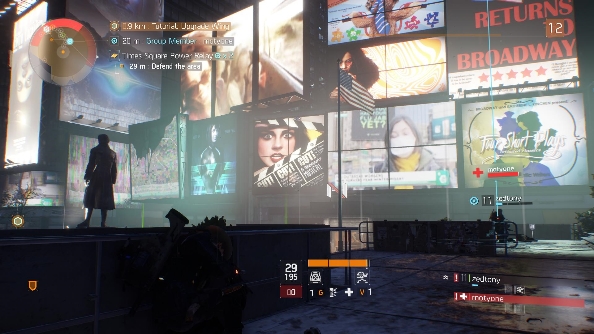
Occasionally missions can be pedestrian, but they’re set in iconic areas of the city that make the campaign a sightseeing tour as much as a Tom Clancy thriller. A personal highlight saw a team and I attempting to switch the lights back on in Times Square, which we undertook during the dead of night. When the generators sparked into life the area was illuminated by the dozens of gigantic TV screens bolted to skyscrapers. Under the gaze of corporate advertising, my squad battled from midnight to daybreak in order to keep our power lines safe.
Outside the bombastic main missions, the multitude of side-quests offer plenty of downtime to simply wander the streets and get a real feel for NYC. It’s these times I recommend playing alone, as not only are these quests easy enough to be mopped up by a single person, but extra human interaction only serves to pull your attention away from The Division’s astonishing world. Side-quests frequently have you hunting down missing agents, and often you’ll be searching for them through abandoned apartment buildings that tell their own stories. Empty rooms show materialistic families who collected all their things and ran, while ones littered with sleeping bags, food packets, and rucksacks tell the tale of people who took in the homeless.
The world also does a very effective job of preying on post-9/11 fears. The sight of skyscrapers with billowing clouds of smoke and flames spurting from windows will always be unsettling, and The Division knows how to use this for impressive impact. Occasionally you’ll come across IEDs hiding among trash bags, or hooded looters trying to break into cars. It’s all reminiscent of news footage from the most frightening disasters of modern history, and while you may be able to fight enemies off with something as absurd as a mine that rolls around BB-8-style before exploding like an anti-aircraft shell, it still feels remarkably grounded and real.
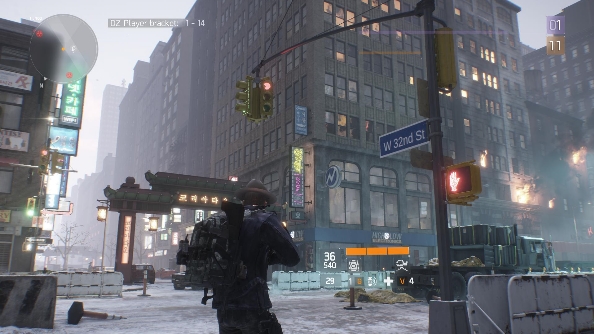
Since The Division is an RPG as much as it’s an open-world shooter, everything you do is geared towards improving your agent. Characters can rank themselves up to level 30, enhancing elements like their general hardiness and how proficient they are with firearms, by gaining XP from kills and missions.
Unlike most RPGs, however, your variety of skills and abilities are not tied to character progression, but to your Base of Operations. Each new facility you set up using currency gained from missions provides you with new abilities, split into three types: skills, talents, and perks.
Skills are cooldown-based abilities used in battle. On offer are things like a chest of medical supplies that heal anyone within a wide area-of-effect, a ballistic riot shield that can keep you safe as you advance, or an automated machine gun turret that mows down enemies for you.
Adding even more depth to skills are modifications which change the way each functions. For example, a seeker mine can be upgraded to either leap into the air by its target and explode overhead, or detonate into numerous mini-mines that search out multiple targets.
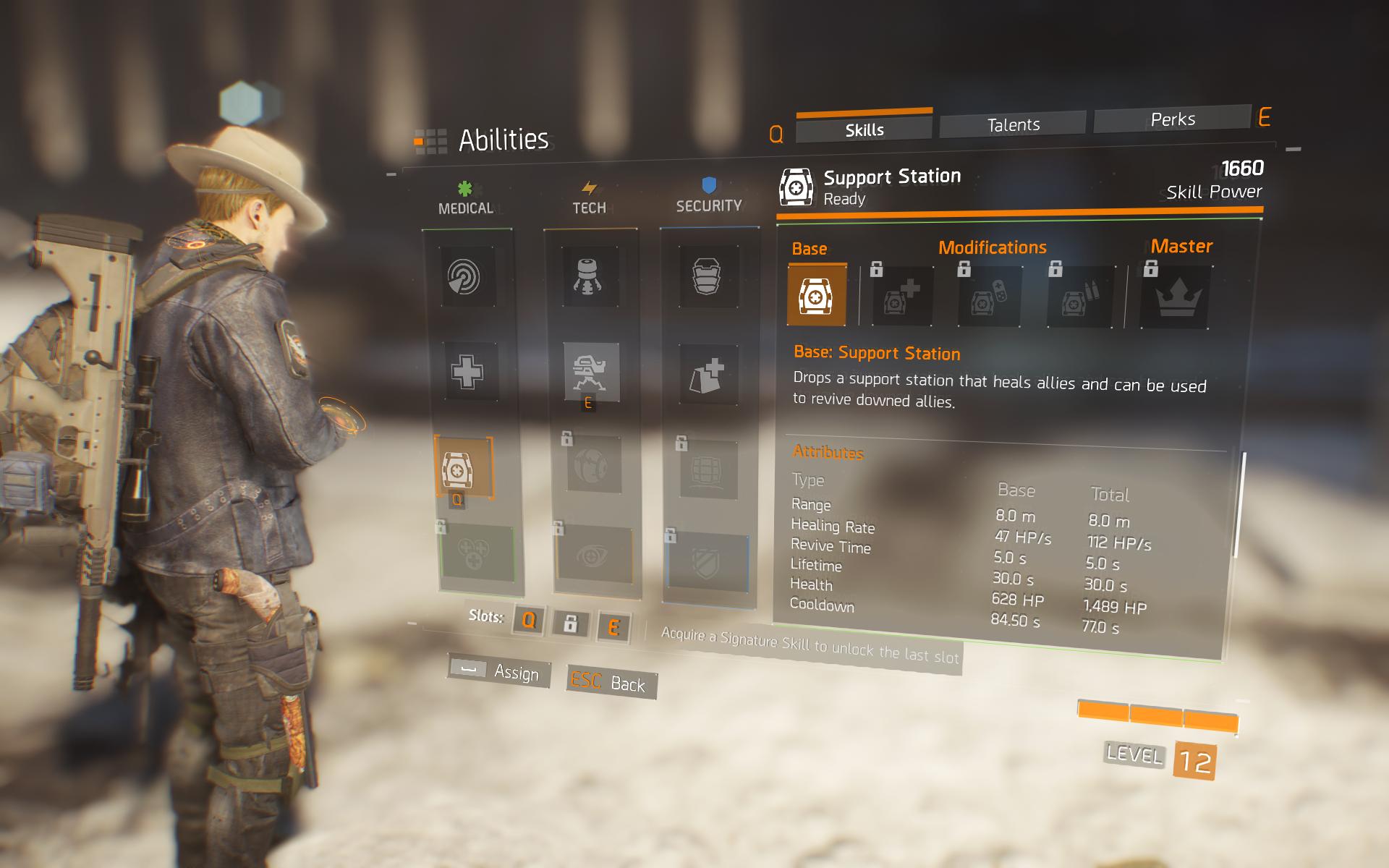
Your hotbar can be outfitted with any three skills from the medical, tech, and security branches, meaning you can create a specialised ‘class’ agent, or something more rounded. You’re never locked into these skills, and every single one can be unlocked, thus your agent can be re-specced whenever the situation calls for it.
The range of skills and modifications means that with each new advancement of your base, combat receives a significant change and upgrade. It’s an essential form of progression since much of The Division is spent engaged in massive firefights. When you’re mixing up the ingredients of those fights from one mission to the next with new skills, any form of stagnation is effectively fended off.
Talents and Perks are less exciting, and while offering something to your character I feel they perhaps unnecessarily overcomplicate things. Talents are small buffs, such as replenishing your ammo if you score a kill with your sidearm, and as you level up you can have more of them equipped. Perks instantly and permanently apply when unlocked, and include boons such as increasing inventory space. Improvements are in tiny steps rather than massive leaps, so it’s sometimes difficult to notice what has changed.
Aside from skills, the other major RPG element of The Division is equipment. Guns and armour are equipped through a deep inventory system that explains the DPS, defence values, and various other stats of gear you’re using. There’s an overwhelming amount of numbers on display, and frequently it all feels a little too much to care about.
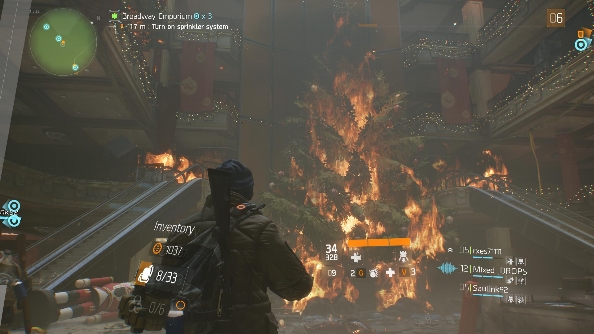
Then there’s the fact that real world items don’t lend themselves well to a game based on finding mass amounts of loot. In something like Diablo better loot equals a jewel-encrusted sword with a blade that eternally sparks with the fires of hell. In The Division, better loot is a kevlar vest with bigger numbers. Are you going to get seriously attached to a kevlar vest? Do you really, honestly care about finding a new assault rifle that has slightly higher stats than the previous one you were using? Because of the gritty, realistic style your character never looks any different regardless of the equipment they’re using, and so it becomes increasingly hard to find loot a motivation for playing.
And loot is the primary reason for playing, at least once the campaign is over and your base is completely upgraded. At level 30 you stop advancing in traditional XP terms, and your progression is based entirely on the combined stats of your gear. To increase that you’ll need to find rarer and more powerful items, all of which can be found in the Dark Zone.
The Dark Zone is the PvP area, and a genuinely superb addition to The Division’s open world. Taking up around a third of the map, it’s guarded by giant walls covered in black sheeting and terrifying biohazard warnings. As you pass through its gates your HUD buzzes and reboots; it’s all very ominous. Inside, eerie music plays, and the world is generally a lot more static. There’s no NPC civilians stumbling around, and fewer signs of life. This really is the city of the dead.
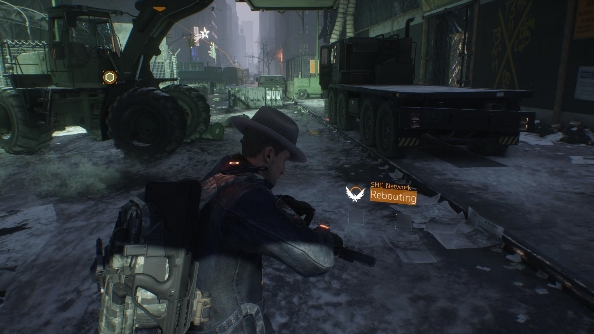
You’ll find no real missions inside the Dark Zone, but there are enemies to be defeated. They’re astonishingly tough and drop powerful loot. Scour the filthy side streets where the contamination is highest and you’ll find special chests containing rare trinkets. You need to be of a specific Dark Zone rank to open these though, which you can rise through by killing enemies in the zone.
Those enemies don’t have to be AI, though. As mentioned before, the Dark Zone is PvP, and so is populated by other players. By default, other players are not your enemies. You’re all in there for the same reason, so if you want to leave them to get on with their hunt for loot then that’s cool. But, aside from scoring kills to increase your Dark Zone rank, there’s another reason why you might want to pop the heads of a few other players.
See, any loot you find in the Dark Zone isn’t yours until you extract it via helicopter. It’s contaminated, and needs to be sent away for a good clean before you can use it. Until extraction, it stays clipped to your belt in a bright yellow bag. That bag may as well be a giant arrow over your head proclaiming ‘This Person Has Stuff Worth Stealing’. So while people may appear to be your friend in the field there’s always that chance that, as you’re waiting for your chopper to arrive, they may hurl a grenade at your feet in the final seconds and take the spoils for themselves.
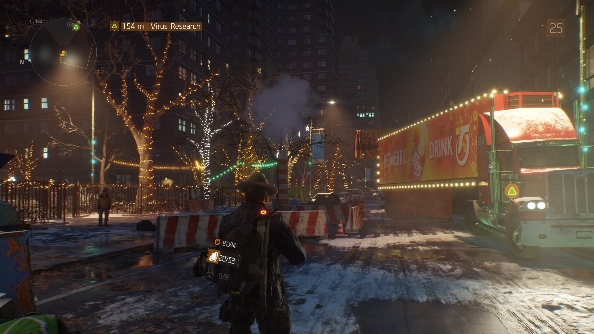
This makes the Dark Zone an incredibly tense experience; a world where everyone is simultaneously playing as a team but deeply distrustful of each other. The emergent storytelling you can extract from a session in the zone is far more effective than anything the main story will provide.
If you’re a bit concerned about DayZ-levels of griefing, don’t panic: players are marked ‘rogue’ when they start to fight other people, and this makes them a target for everyone on the server. Dying too many times lowers your Dark Zone ranking, meaning you’ll be prevented from unlocking those chests or buying the best items at a vendor, so the game does actively encourage you to stay on the right side of being a total dick.
Brilliant as it is though, I’m not sure the Dark Zone can sustain the months – and certainly not years – of continued play that Ubisoft hopes it will. Since PvP is, basically, just causing fights in the streets with other players, there’s no leaderboards or match structure like in a ‘proper’ multiplayer game, and thus the longevity is entirely at the mercy of how wrapped up in loot you become. If you simply can’t become obsessed with finding ever better numbers, then the zone eventually loses its lustre.
Back in the PvE zones, the only thing to do after hitting end game is to re-do campaign missions at higher difficulties, or complete daily challenges. Doing so requires better equipment, and thus The Division’s gameplay loop reveals itself.
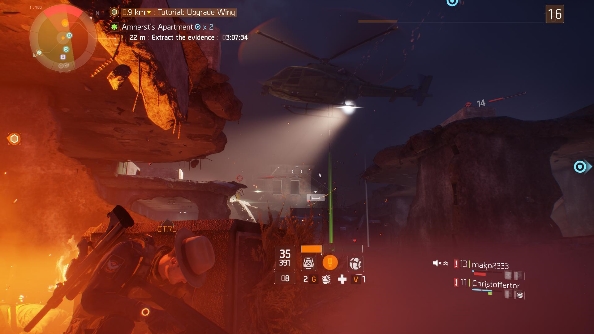
While more missions and other content will appear in a combination of free updates and paid-for DLC expansions, I really think The Division needs a bigger driving force behind its endgame to justify its MMO-like ambitions. A complicated, challenging raid with six players would have been ideal, providing a true motivation for finding all that extra gear.
As it stands, I feel that The Division would have been better scrapping the deepest of its RPG elements and sticking to being a great co-op shooter with a replayable campaign. And you can certainly play that game here no problem, but the mass amount of numbers and stats will always be present to bog you down. Perhaps those RPG elements are the framework for something outstanding that’s due to arrive further down the road. Right now though, they’re the weakest component by far.
The Division’s astonishing complexity makes it appear to be one of Ubisoft’s most ambitious games to date. But that’s actually smoke and mirrors, because the key components are remarkably simple. Underneath it all, this is a classic Ubisoft open-world game, bolstered by fantastic co-op and PvP support, and marred by RPG percentages that are as intrusive as they are ineffective. Approach it with the view to completing the campaign and sightseeing New York with friends and you’ll have a blast. But this isn’t a world you’ll be living in for years to come.
